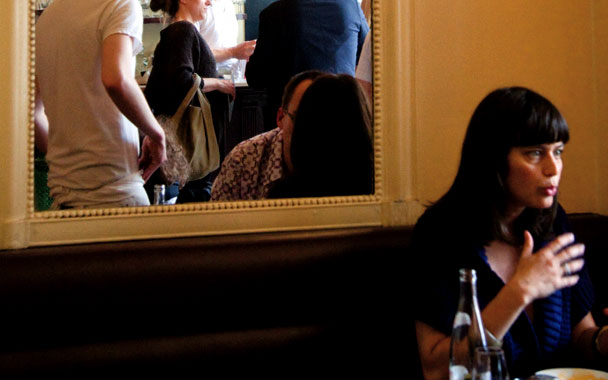Anyone who goes to Paris to eat will tell you that the city has been steadily tilting east, specifically toward the 11th and 12th arrondissements. This is why I find myself staring at an exhibit of the potato-producing countries of the world inside a display case in the Parmentier métro station. A wonderful expression of the French penchant for public edification, this stop was named in honor of Antoine-Augustin Parmentier, the agronomist who convinced his countrymen that potatoes were indeed edible (they were originally cultivated in France only as animal feed, and it was assumed their tubers were toxic to humans). The honor is appropriate, not only because of the shared subterranean bond between the subway and the elegantly named pomme de terre (“apple of the earth”), but also because the denizens of this venerable working-class district subsisted on a steady diet of potatoes for a long time.
Who knows what Parmentier would have made of the sudden popularity of daikon, wasabi, and all the other exotic root vegetables that have become a mainstay on menus in the 11th and 12th? My guess is he’d be dumbstruck to find that this slice of the city has become its trendiest gourmet destination, especially for those who want to taste what’s new without spending a small fortune.
L’est populaire, which encompasses the old, proletarian neighborhoods of Oberkampf, Ménilmontant, Bastille, Faubourg Saint-Antoine, Daumesnil, and Bercy, has gone gastro in a major way. It’s here that countless young chefs have chosen to set up shop, due in no small part to the low rents, but also to the demographic turnover that’s seen an influx of well-heeled bobos (bourgeois bohemians) with adventurous palates and a love of good food.
It was, curiously enough, the Opéra Bastille that got the ball rolling. This much-derided building (many still compare it to a lavatory thanks to its glass blocks and skin of pale-green tiles)—commissioned by President François Mitterrand as a symbol of his Socialist party’s devotion to making the performing arts accessible to working people—opened on July 13, 1989, to commemorate the 200th anniversary of the storming of the Bastille. Ironically, by drawing thousands of affluent Parisians to this part of the city for the first time (many of the locals found the programming uninteresting and the ticket prices too high), he set the stage for a real-estate revolution.
Hot spots like the pioneering (but now defunct) China Club, a Shanghai-in-the-’30s-themed bar and restaurant, opened to cater to the fashionable culture vultures who discovered the charm of this old-fashioned neighborhood, which had been the center of furnituremaking in Paris for centuries (and which had already acquired a gloss of bohemian glamour from the free spirits who’d seized upon the low rents along the Rue de Lappe and the Rue Saint-Sabin a few years earlier). Following the completion of a second set of public works in the mid-’90s, these arrondissements—which had previously lacked any major attractions (even the perennially trendy Père-Lachaise cemetery is just across the street, in the 20th)—became a destination for a broader public. The change began 14 years ago with the conversion of a long-abandoned railway viaduct into the Promenade Plantée, a green-belt walkway that runs all the way to the edge of the city. Underneath it, in a series of brick arches that were the support for the tracks themselves, the Viaduc des Arts became a street-level parade of shops devoted to arts and artisans. (Check out the handmade copper cookware at L’Atelier des Arts Culinaires.) In nearby Bercy, the transformation of the handsome brick warehouses that formerly served the wholesale wine trade (barges from Burgundy unloaded their cargo here) into shops, cafés, and restaurants gave way to a whole new neighborhood. Et voilà, eastern Paris, once snobbishly dismissed by the bourgeoisie, was suddenly hot, even fashionable.




 Pinterest
Pinterest


